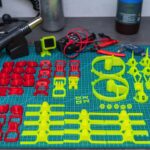I. Understanding Upcycled Art: Definition and Concept
II. The Benefits of Upcycled Art: Environmental and Creative Impact
III. How to Create Upcycled Art: Materials, Techniques, and Inspiration
Understanding Upcycled Art: Definition and Concept
Welcome to the fascinating world of upcycled art! You might be wondering, what exactly is upcycled art? Simply put, it’s a creative endeavor that takes discarded materials and transforms them into new, artistic pieces. Think of it as giving a second life to items that might otherwise end up in a landfill. It’s not just about recycling; it’s about reimagining!
Upcycled art goes beyond just reusing materials; it’s a blend of creativity and sustainability. Artists often scavenge for items that others might overlook, such as:
- Old furniture
- Glass bottles
- Scrap metal
- Clothing and fabric scraps
- Wood pallets
- Electronic waste
These materials can be transformed into stunning sculptures, functional home decor, or even intricate jewelry. The beauty of upcycled art lies in its potential to tell a story, evoke emotions, and showcase a unique perspective on consumerism and waste.
The Philosophy Behind Upcycled Art
At its core, upcycled art challenges the notion of “waste.” It invites us to think differently about the objects we discard. Instead of viewing them as garbage, upcycled artists see potential. This philosophy not only encourages creativity but also promotes a more sustainable way of living.
Many upcycled artists are motivated by a desire to reduce their environmental footprint. By using materials that already exist, they minimize the demand for new resources. It’s a win-win situation: the planet benefits, and the artist gets to express their creativity!
Upcycled Art in Various Forms
Upcycled art can take many forms, allowing for endless possibilities. Here are a few popular categories:
- Functional Art: This includes items like furniture made from reclaimed wood or light fixtures created from repurposed glass. These pieces serve a purpose while also being aesthetically pleasing.
- Sculpture: Artists might create large-scale installations or small sculptures using metal scraps, plastic, or even found objects from nature.
- Textile Art: This involves sewing, weaving, or quilting with old clothing or fabric scraps to create beautiful, textured pieces.
- Mixed Media: Many artists combine various materials—like paint, paper, and fabric—to create multi-dimensional artworks that challenge traditional techniques.
As you can see, upcycled art is as diverse as the materials used to create it. Each piece is a unique expression of the artist’s vision and values, making it not just art, but a statement about our world.
Why You Should Care
Understanding upcycled art is important not just for artists, but for everyone. It encourages us to rethink our consumption habits and promotes a culture of creativity and sustainability. Whether you’re an aspiring artist or simply someone who enjoys art, appreciating upcycled pieces can inspire you to look at the world a little differently!
So, next time you see something that’s “past its prime,” consider the magic that might be waiting to be uncovered. Who knows? You might just find inspiration for your own upcycled masterpiece!
The Benefits of Upcycled Art: Environmental and Creative Impact
Upcycled art is more than just a creative outlet; it’s a powerful statement about sustainability and resourcefulness. By transforming discarded materials into beautiful works of art, we not only reduce waste but also unlock a treasure trove of possibilities for our creative expression. Let’s dive into the myriad benefits of upcycled art—both for our planet and our imaginations!
1. Environmental Benefits
First and foremost, let’s talk about the environmental impact. In a world overflowing with waste, upcycled art offers a refreshing solution:
- Reduces Waste: Every piece of upcycled art starts with something that would have otherwise ended up in a landfill. By reimagining these materials, you’re actively helping to reduce waste and extend the life cycle of products.
- Conserves Resources: Creating new materials often requires a significant amount of energy and resources. Upcycling minimizes the need for new raw materials, making it a more sustainable choice.
- Promotes a Circular Economy: Upcycled art encourages a shift from a linear (“take-make-dispose”) economy to a more sustainable circular model. This means reusing what we already have and reducing our reliance on new products.
2. Creative Benefits
The creative benefits of upcycled art are just as compelling as the environmental ones. Here’s how diving into this artistic practice can boost your creativity:
- Encourages Innovation: Upcycling pushes you to think outside the box. You might find yourself using materials in ways you never imagined, sparking creativity you didn’t know you had!
- Fosters Unique Creations: Each piece of upcycled art is one-of-a-kind. You’re not just making art; you’re telling a story with every scrap and component you use.
- Provides a Sense of Accomplishment: There’s something incredibly satisfying about turning forgotten items into stunning artwork. Completing an upcycled project can boost your self-esteem and encourage you to tackle even bigger creative challenges.
3. Community Engagement
Upcycled art doesn’t just benefit the individual artist; it brings communities together. Here’s how:
- Builds Connections: Participating in upcycling workshops or community art projects fosters a sense of belonging. You get to meet like-minded individuals who share your passion for creativity and sustainability.
- Inspires Change: By showcasing your upcycled art, you can inspire others to rethink waste and consider more sustainable practices in their own lives.
4. Personal Growth and Mindfulness
Finally, engaging in upcycled art can lead to personal growth and a sense of mindfulness:
- Promotes Mindfulness: The process of transforming materials into art encourages you to slow down and appreciate the present moment. It’s therapeutic and can help reduce stress.
- Teaches Valuable Skills: From problem-solving to crafting techniques, upcycling can equip you with a variety of skills that enhance your artistic journey.
In conclusion, upcycled art is a win-win for both the environment and our creative spirits. So why not grab some old items around your home, channel your inner artist, and start creating? You’ll be doing your part for the planet while discovering the joy of turning the old into something spectacular!
How to Create Upcycled Art: Materials, Techniques, and Inspiration
Creating upcycled art is not just a way to give new life to old materials; it’s also an exciting journey of creativity and self-expression. So, let’s dive into how you can get started on your own upcycled art projects!
Gathering Materials
The first step in your upcycling adventure is to gather materials. One of the best parts about upcycled art is that you probably already have some fantastic items lying around your home. Here are some common materials to consider:
- Old magazines and newspapers: Great for collage art!
- Glass jars: Perfect for sculpture or functional art.
- Fabric scraps: Ideal for textile art and soft sculptures.
- Wooden pallets or crates: Excellent base for furniture or wall art.
- Plastics: Bottles and containers can be transformed into stunning pieces.
Don’t forget to check out thrift stores or garage sales for even more materials. The key is to keep an open mind—what might seem like trash to one person could be a treasure in your hands!
Techniques to Explore
Once you have your materials, it’s time to get creative with different techniques! Here are some popular methods to inspire your projects:
- Collage: Layering different materials can create unique textures and images. Use old magazines, photographs, and paper scraps for a dynamic piece.
- Assemblage: Combine various items to create a three-dimensional art piece. Think of it like building a sculpture with found objects!
- Decoupage: This technique involves gluing paper onto surfaces, then sealing it with a finish. It’s perfect for decorating furniture or household items.
- Painting and Stenciling: Use leftover paints or spray paints to bring color to your upcycled pieces. Stencils can help you add intricate designs!
- Sewing or Quilting: If you’re working with fabric, sewing pieces together can create beautiful quilts or soft sculptures.
Finding Inspiration
Feeling stuck? Don’t worry; inspiration is everywhere! Here are some tips to get those creative juices flowing:
- Nature: Take a walk outside and observe the shapes, colors, and textures around you.
- Art communities: Join local workshops or online groups focused on upcycled art to share ideas and gain insights.
- Social media: Platforms like Pinterest and Instagram are full of fantastic upcycling projects. Follow artists who inspire you!
- Art exhibits: Visiting galleries can spark ideas and expose you to different styles and techniques.
Remember, the beauty of upcycled art lies in its imperfection and uniqueness. Don’t be afraid to experiment, and most importantly, have fun with your creations! Every piece you make is not only a reflection of your creativity but also a step towards a more sustainable world.
So, gather those materials, unleash your imagination, and start creating your very own upcycled masterpieces today!








Comments